Performance Plan Summary Table
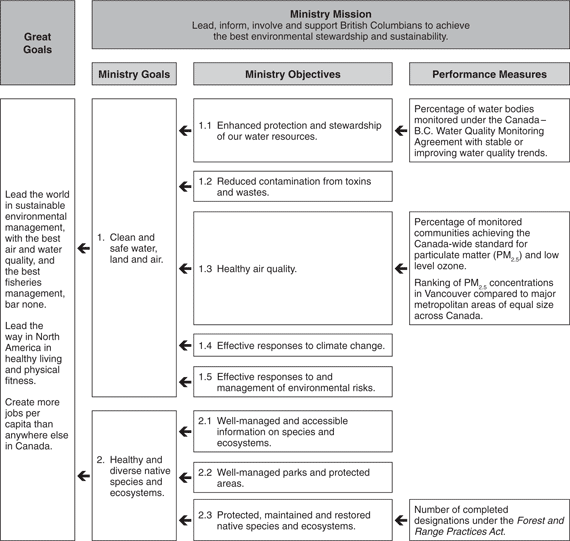
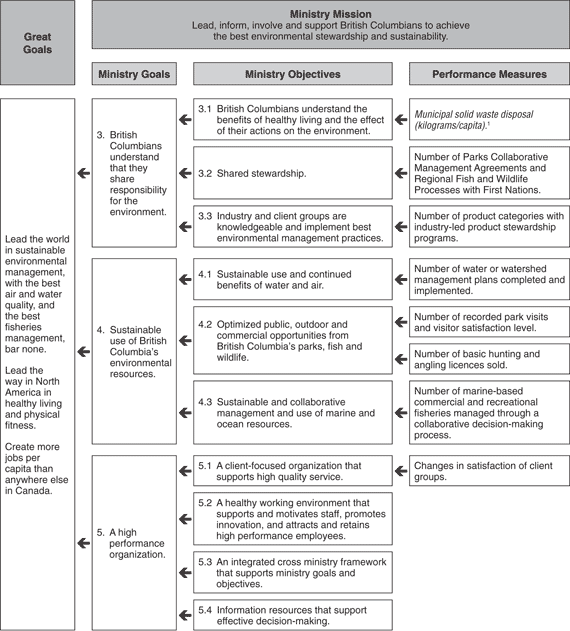
Significant effort has been made over the previous year to continually refine and update the strategies detailed in last year's
Service Plan. The strategies that are included in this year's plan are those that represent overall priorities for the government,
ministry and British Columbians.
The following sections provide an overview of each ministry goal and present a detailed accounting of the supporting objectives,
strategies and performance measures. These measures do not tell us everything about the ministry's performance, but they can
be used to show our progress in areas of environmental protection, stewardship and management. The results of these measures
are reported in ministry annual reports.
| Goal 1: |
Clean and safe water, land and air. |
Healthy communities and a healthy environment depend on clean and safe water, land and air. This goal reflects the ministry's
commitment to enhanced protection of our water resources, reduced contamination of land and air, and effective responses to
climate change and environmental emergencies. Achievement of this goal is vital to a healthy and sustainable environment for
British Columbia, and supports the government's broader goal to have the best air and water quality in North America.
Core Business Areas: Water Stewardship, Environmental Protection and Compliance.
Objective 1: Enhanced protection and stewardship of our water resources.
A safe and sustainable supply of high quality water is vital to our communities, economy and environment. Both protection
and stewardship of our water resources are of utmost importance to the ministry. Achievement of this objective through effective
legislation, innovative approaches to water governance and coordinated watershed-based planning contributes directly to the
goal and is critical to the health of British Columbians and the environment.
A key strategy for this objective is implementing the B.C. Water Action Plan. Under this strategy, actions include:
- integrating cross ministry initiatives to promote and enhance water stewardship;
- developing and implementing proactive planning and adaptation strategies to address emerging issues and cumulative effects
(e.g., climate change, population growth and mountain pine beetle);
- encouraging local governments to include water stewardship and long-term sustainability in their planning and development
programs;
- continuing to ensure safe and secure drinking water sources through the ministry's source water protection program;
- continuing to lead the development of water use plans and monitoring of water licence requirements;
- ensuring well-managed and accessible water resource information to support effective decision-making informed by science;
- identifying and improving collaboration among government, academia and industry on science, research and monitoring to ensure
continuous improvement in our knowledge of the provincial water resources.
Water quality trends in water bodies monitored under the Canada–B.C. Water Quality Monitoring Agreement
Communities, ecosystems, wildlife, aquatic life, fisheries and industry all rely on a safe and sustainable supply of high
quality water. Water quality and supply is affected by industrial and development activities, as well as by the everyday activities
of individuals. This is why ongoing monitoring, protection and management of British Columbia's water sources are so important
and are a priority for the government.
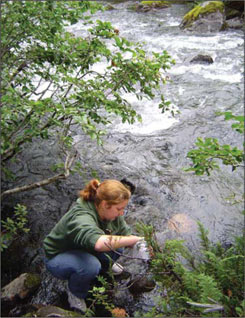 This measure monitors trends in surface water quality-based on the presence of environmentally significant variables, such
as metals and nutrients, within 30 water bodies monitored under the Canada–B.C. Water Quality Monitoring Agreement.4 The purpose of the agreement is to provide for the coordination and integration of Canada and B.C. surface water quality
monitoring activities to develop joint, cost-shared, comprehensive assessments of water quality. To determine which water
bodies are monitored under the agreement, the ministry bases its decisions on provincial coverage, water use, alternative
monitoring agencies such as regional districts, and events or issues near water bodies that may have negative consequences
for the water quality of those water bodies. In total, there are thirty-eight stations monitored, although eight of these
are new monitoring stations that have been added in the past two years. Water quality trends cannot be determined at sites
until data have been collected for a minimum of five years.
This measure monitors trends in surface water quality-based on the presence of environmentally significant variables, such
as metals and nutrients, within 30 water bodies monitored under the Canada–B.C. Water Quality Monitoring Agreement.4 The purpose of the agreement is to provide for the coordination and integration of Canada and B.C. surface water quality
monitoring activities to develop joint, cost-shared, comprehensive assessments of water quality. To determine which water
bodies are monitored under the agreement, the ministry bases its decisions on provincial coverage, water use, alternative
monitoring agencies such as regional districts, and events or issues near water bodies that may have negative consequences
for the water quality of those water bodies. In total, there are thirty-eight stations monitored, although eight of these
are new monitoring stations that have been added in the past two years. Water quality trends cannot be determined at sites
until data have been collected for a minimum of five years.
The results of this measure will provide a good indication of the outcomes of water protection efforts and stewardship of
the province's water resources.
| Performance Measure |
2006/07
Baseline |
2007/08
Target |
2008/09
Target |
2009/10
Target |
| Percentage of water bodies monitored under the Canada–B.C. Water Quality Monitoring Agreement with stable or improving water
quality trends 1 |
96%
(2006/07 data) |
96% or greater |
96% or greater |
96% or greater |
Objective 2: Reduced contamination from toxins and wastes.
Disposing of the toxins and wastes generated each year comes at significant costs. These costs include financial costs associated
with shutting down landfills and establishing new ones, dealing with the contamination of land, water and air, and addressing
the impact on ecosystems and the health of citizens. By reducing contamination from toxins and wastes efficiently and effectively,
the ministry will minimize impacts to water, land, air, human health and safety, and the economy.
Key strategies for this objective include:
- exploring new ways to reduce municipal solid waste disposal;
- increasing the number of products requiring industry-led product stewardship programs;
- supporting the development of a brownfields5 strategy for B.C.;
- promoting the development and adoption of integrated pest management practices;
- developing a results-based regulatory regime that provides clear roles for government and stakeholders.
Objective 3: Healthy air quality.
Protecting the quality of the air remains a key focus of the ministry. Healthy air quality means healthy people and a healthy
environment. Taking action to reduce air pollution will help improve the health of British Columbians, address the government's
air quality targets, preserve our environment and enhance our economic competitiveness.

A key strategy for this objective is leading the implementation of B.C.'s Air Action Plan. Components of this plan include:
- ensuring well-managed and accessible air resources information to support science-based decision-making;
- continuing to reduce emissions from industry, transportation and urban growth;
- working with partners to reduce emissions from ports and marine vessels;
- continuing to develop and support airshed management.
Air quality
The outdoor air contaminants of most concern in British Columbia, from a human health and ecosystem perspective, are airborne
particulate matter (PM) and low level or ground level ozone.
PM2.5 refers to "fine" particles less than 2.5 micrometres in size (or about 1/20th the width of a human hair). These fine particulates,
which are most often generated by combustion processes and by chemical reactions taking place in the air, are easily inhaled
and penetrate into the lungs, posing a threat to human health.
Although ozone in the stratosphere (the ozone layer) is beneficial and filters out harmful ultraviolet rays, ground level
ozone is a pollutant and can be damaging to human health and the environment. Ground level ozone can result from the incomplete
combustion of fuel, as well as from the evaporation of fuels, solvents, paints and dry-cleaning fluids, or from natural sources,
such as biogenic emissions from vegetation or from down-mixing from the stratosphere to the troposphere, which is the layer
of air we live in.
To measure our efforts and commitments to clean and safe air, the ministry tracks the percentage of monitored B.C. communities
achieving the Canada-wide standards6 for PM2.5 and ground level ozone. The ministry collects PM2.5 data from approximately 80 air quality monitoring sites from over 45 communities, and ground level ozone data from approximately
30 sites from over 25 communities across the province. The monitors are typically placed in communities that are densely populated
and or where air quality may be an issue. In order to report on a community's air quality, data must be analyzed using a statistical
analysis program. Statistically sufficient data must be generated in order to report the results of a monitoring station.
In addition, the location of the monitoring station may change over time. For these reasons, the number of communities that
can be reported may change over time. The number of communities reported for PM2.5 has increased since 2002. The number of communities reported for low level ozone increased from 2002 to 2004 and then decreased
in 2005.
The government is also tracking the annual average PM2.5 concentrations in major metropolitan areas across Canada (Figure 1). Vancouver is currently ranked second-best, after Calgary,
when compared to other areas of similar size. The key instrument to improving air quality in Vancouver is the Greater Vancouver
Regional District's Air Quality Management Plan. The government is working with the GVRD to support implementation of this
plan and achievement of local airshed goals.

Figure 1. PM2.5 concentrations in Canadian cities
| Performance Measure |
2006/07
Baseline |
2007/08
Target |
2008/09
Target |
2009/10
Target |
| Percentage of monitored communities achieving the Canada-wide standard (CWS) quality objective for PM2.5 and low level ozone
|
PM2.5: 88%
(2005 data)
Low level ozone: 96%
(2005 data) |
Maintain or improve |
Maintain or improve |
100% by 2010 |
| Performance Measure |
2006/07
Baseline |
2007/08
Target |
2008/09
Target |
2009/10
Target |
| Ranking of Vancouver for PM2.5 concentration compared to major metropolitan areas of equal size across Canada1 |
2nd lowest at 6.8 µg/m3
(2004 data) |
Maintain or improve |
Maintain or improve |
Maintain or improve |
| Vancouver will be ranked number one by 2015/16 |
Objective 4: Effective responses to climate change.
Climate change is an issue that has local, regional and global significance. All jurisdictions, including British Columbia,
which is experiencing some warming and climate-related impacts, have a role to play in reducing emissions that contribute
to climate change. The ministry is the lead agency for the provincial government's response to climate change. Work to date
has included strategies to reduce provincial greenhouse gas emissions (mitigation), as indicated in B.C.'s 2004 climate change
plan (Weather, Climate and the Future: B.C.'s Plan), as well as activities to prepare the province for events associated with climate change and related extreme weather (adaptation).
Information from the scientific community advises, however, that absolute reductions in greenhouse gas emissions are required
if we are going to have an impact on climate change. As a result, the province has established targets to reduce B.C.'s greenhouse gas emissions by at least 33 per cent below
current levels by 2020. A Climate Action Team will be established and through consultations will determine sector targets
for 2012 and 2016. Legislation will be developed over the next year to phase in new requirements for methane capture in our
landfills, the source of about nine per cent of B.C.'s greenhouse gas emission.
Objective 5: Effective responses to and management of environmental risks.
Events in the environment, such as oil spills and flooding, can present risks to public health and safety, property and the
environment itself. Although not all environmental risks are avoidable, effective management means that impacts from risks
can be minimized. The ministry anticipates, responds to and manages the consequences of risks to the environment.
Key strategies for this objective include:
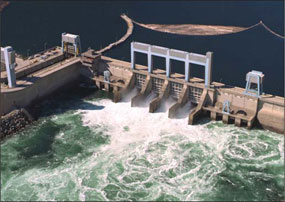 preparing for and responding effectively to high risk environmental emergencies such as oil spills, hazardous material spills,
gas leaks and flood and debris flows;
preparing for and responding effectively to high risk environmental emergencies such as oil spills, hazardous material spills,
gas leaks and flood and debris flows;- developing a strategy to enhance partnerships for environmental stewardship in spill responses;
- reducing the risk to public safety througheffective flood hazard management (working with local governments), drought management
and dam safety programs;
- providing effective and timely forecasting of floods and droughts;
- reducing the risk to public safety through effective human-wildlife management and response programs;
- reducing the risk to the environment and human health and safety through effective compliance and enforcement strategies and
actions, including development of a commercial environmental investigation unit;
- remediation of high risk contaminated sites.
| Goal 2: |
Healthy and diverse native species and ecosystems. |
Healthy and diverse native species and ecosystems provide significant environmental, social and economic benefits to British Columbia
and its people. To achieve this goal, the ministry develops, manages, regulates and enforces environmental programs and legislation
that contribute significantly to ensuring the health and diversity of native species and ecosystems.
Core Business Areas: Environmental Stewardship, Oceans and Marine Fisheries, Compliance.
Objective 1: Well-managed and accessible information on species and ecosystems.
The collection, storage, management and distribution of scientific information on native species and ecosystems provides for
effective research, contributes to the understanding of the status of native species and ecosystems and is critical to making
informed decisions.
Key strategies for this objective include:
- compiling, consolidating, analyzing and distributing information on species and ecosystems;
- communicating the conservation status of species and ecosystems;
- providing guidelines and standards for the protection and conservation of species and ecosystems, including monitoring and
reporting on achievements;
- assessing the conservation status of plants, animals and ecosystems and related risks and threats within parks and protected
areas.

Objective 2: Well-managed parks and protected areas.
Parks and protected lands have great conservation value and provide a place for native species to exist in their natural environment.
The designation of parks and protected lands means these areas will be preserved for future generations and demonstrates British Columbia's
commitment to the conservation of native species and ecosystems.
Key strategies for this objective include:
- continuing to identify, designate and manage parks and protected lands;
- undertaking parks and protected lands planning and management to ensure long-term protection of natural, cultural and recreational
assets;
- maintaining and promoting partnerships for securing and managing parks and protected lands;
- continuing to evaluate the assets of protected areas to support sound decision-making;
- incorporating the Healthy By Nature7 messages into BC Parks communications;
- adopting best business practices to optimize parks system management.
Objective 3: Protected, maintained and restored native species and ecosystems.
British Columbia is home to a rich diversity and abundance of native species and habitats. Programs within the ministry conserve
biodiversity, maintain and enhance native ecosystems and achieve a balance between the needs of wildlife and the needs of
people. The ministry encourages others to accept a greater role in environmental stewardship and facilitates community initiatives
to protect and restore local environments.
Key strategies for this objective include:
- continuing to work with and expand partnerships, including those with First Nations, to identify, protect and restore species
and ecosystems;
- continuing to assess and monitor fish and wildlife populations and ecosystems to support improved resource management;
- continuing to assess, monitor and manage wildlife health;
- continuing to develop guidelines, policies and standards for the protection and conservation of species and ecosystems;
- continuing to monitor the effectiveness of and compliance with fish and wildlife guidelines;
- developing and implementing an enhanced legal and policy framework and regional-based planning programs;
- providing scientific advice to decision makers and those responsible for developing and implementing resource use policies
and land use planning initiatives;
- providing leadership in species at risk ranking and designation, and preparation and implementation of recovery plans;
- developing and implementing a provincial policy that balances water flow requirements for species, ecosystems, communities
and industries;
- leading, in collaboration with the federal government, the development of a marine protected area system for the Pacific coast;
- developing and implementing a provincial human-wildlife conflict policy and response program to provide maximum wildlife protection
consistent with public safety;
- developing and implementing sustainable fish and wildlife harvest policies that balance conservation, public safety and user
demand;
- partnering with resource agencies on provincial access management;
- reducing risk to native species and ecosystems by responding to offences with effective compliance and enforcement strategies
and actions, including implementation of Seasonal Conservation Officers.
Number of completed designations under the Forest and Range Practices Act
Designations under the Forest and Range Practices Act provide special management for species impacted by forest and range activities on Crown land. These designations provide
legislated protection for habitats and contribute significantly to the conservation of native species. Because the Forest and Range Practices Act is a critical piece of legislation for protecting and restoring species and their habitats, it is important to measure ministry
progress in establishing environmental standards under the Act.
The ministry is assessing its progress by monitoring the number of legal designations for Wildlife Habitat Areas, Ungulate8 Winter Ranges and Fisheries Sensitive Watersheds. The inclusion of Fishery Sensitive Watersheds in this measure is new. Fishery
Sensitive Watershed designations provide valuable protection to fish in some of B.C.'s watersheds that are most sensitive
to forest and range activities. To adequately demonstrate progress, two types of data are being collected: (1) the number
of designations and objectives established, and (2) the area of forest land base for which designations and objectives have
been established.
The targets for approval of Ungulate Winter Range designations will remain stable over the next three years, reflecting an
expected decrease in Ungulate Winter Range plans remaining for approval when compared with the period from 2003/04 – 2006/07.
| Performance Measure |
2006/07
Baseline |
2007/08
Target |
2008/09
Target |
2009/10
Target |
| Number of completed designations by the Ministry of Environment under the Forest and Range Practices Act, including Wildlife Habitat Areas (WHA), Ungulate Winter Ranges (UWR), and Fisheries Sensitive Watersheds (FSW)
|
414 WHA
(668,424 hectares) |
444 WHA |
474 WHA |
504 WHA |
35 UWR*
(2,658,725 hectares) |
40 UWR |
45 UWR |
50 UWR |
17 FSW (3,873,980 hectares)
(designations approved as of March 2006) |
27 FSW |
37 FSW |
47 FSW |
| Goal 3: |
British Columbians understand that they share responsibility for the environment. |
Environmental sustainability can neither be created by governments nor imposed by public policy. It depends on the collective
knowledge, commitment and actions of individuals, organizations, communities and all levels of government as a whole. Achievement
of this goal requires strong and expanded partnerships with industry and stakeholders, and an environmentally conscious and
knowledgeable public. Having a society in which individuals act as stewards by considering the environmental impacts of their
individual and collective actions will be a great step toward sustainability.
Core Business Areas: Environmental Stewardship, Water Stewardship, Environmental Protection, Oceans and Marine Fisheries, Compliance, Executive
and Support Services.
Objective 1: British Columbians understand the benefits of healthy living and the effect of their actions on the environment.
In order for a society to become environmentally conscious, its citizens must understand the relationship between their actions
and how those actions directly impact their health, the quality of their lives, and the lives of other people and species
with which they share ecosystems. As British Columbians continue to make the connection between actions and impacts, they
are much more likely to take on the role of stewards and demand a much higher environmental standard for their own actions
and those of others.
Key strategies for this objective include:
- implementing and supporting a comprehensive and integrated ministry stewardship outreach strategy;
- promoting outdoor activities as beneficial for a healthy lifestyle.
Municipal and solid waste disposal
The ministry is developing a performance measure that measures the reduction of municipal solid waste disposal per capita.
This measure reflects the commitment by businesses and the public to reduce their impacts on the environment and to support
a healthy economy and healthy communities. Improved environmental practices, reduction in consumption or use of raw materials
in production, reuse of materials collected through blue box programs, recycling of beverage containers and composting kitchen
and yard waste all contribute to a reduction in municipal solid waste disposal.
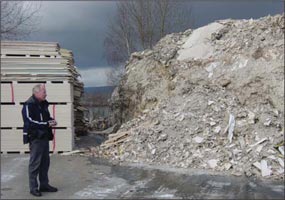 Provincial municipal solid waste disposal is governed under the Environmental Management Act. Under the Act, the province requires local governments to prepare municipal solid waste management plans designed to minimize
waste going to landfills and maximize reuse and recycling initiatives. Reduction and disposal of municipal solid waste is
the responsibility of the province's 29 regional districts. Regional districts weigh the amount (in kilograms) of municipal
solid waste disposed of in municipal landfills annually. The waste being tracked is generated by residents, businesses and
institutions.
Provincial municipal solid waste disposal is governed under the Environmental Management Act. Under the Act, the province requires local governments to prepare municipal solid waste management plans designed to minimize
waste going to landfills and maximize reuse and recycling initiatives. Reduction and disposal of municipal solid waste is
the responsibility of the province's 29 regional districts. Regional districts weigh the amount (in kilograms) of municipal
solid waste disposed of in municipal landfills annually. The waste being tracked is generated by residents, businesses and
institutions.
In 2006, the ministry commissioned the Recycling Council of British Columbia to collect municipal solid waste data from all
regional districts for the period of 2003 to 2005. The results of the report, which will be released in 2007, will be analyzed
and discussed with regional districts and other stakeholders to help determine annual municipal solid waste reduction targets
for the province. This performance measure and multi-year targets will be completed by the end of the 2007/08 fiscal year.
Objective 2: Shared stewardship.
Public and stakeholder expectations of meaningful involvement in decision-making and in sharing responsibility for environmental
outcomes continue to be a force for change in the way the ministry does its business. The ministry recognizes that a successful
shared stewardship model needs to integrate cooperative and collaborative partnerships across all sectors and geographic jurisdictions.
Necessary tools include sharing information and knowledge, consultation and partnering opportunities.
Key strategies for this objective include:
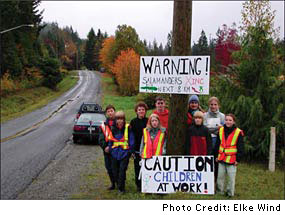 recognizing, promoting, and enhancing shared stewardship through consultative processes and volunteer initiatives that engage
stakeholders, clients and partners;
recognizing, promoting, and enhancing shared stewardship through consultative processes and volunteer initiatives that engage
stakeholders, clients and partners;- promoting sustainable natural resource management through collaborative management and decision-making processes;
- pursuing opportunities for the Conservation Officer Service to provide shared compliance and enforcement activities through
partnerships with other agencies;
- enhancing and promoting shared stewardship through effective and timely communication of compliance activities taken to protect
the environment.
Number of partnerships with First Nations
The ministry is monitoring its progress in forging partnerships with First Nations. In the past, the ministry has used a performance
measure based on the number of Parks Collaborative Management Agreements with First Nations. This measure has been expanded
to include the number of official Regional Fish and Wildlife Processes.
The ministry currently has sixteen Park Collaborative Management Agreements in place for parks and protected areas. These
agreements are generally linked to the creation of new protected areas in land use plans, but in a number of cases are being
discussed in the context of treaty negotiations or other provincial initiatives. Parks Collaborative Management Agreements
define how the province and First Nations will work together on the management of protected areas.
There are currently five Regional Fish and Wildlife Processes in place. These processes are designed to provide a region-wide
perspective and actively engage First Nations and key stakeholders, with a direct interest in fish and wildlife, in a forum
to discuss management and allocation issues.
Currently, 115 of 198 bands (representing 58 per cent of British Columbia's First Nation bands) are engaged in Parks Collaborative
Management Agreements and or Regional Fish and Wildlife Processes with the ministry. Both of these processes provide a significant
role to First Nations in making recommendations around protected areas and fish and wildlife management.
| Performance Measure |
2006/07
Baseline |
2007/08
Target |
2008/09
Target |
2009/10
Target |
| Number of Parks Collaborative Management Agreements (PCMA) and Regional Fish and Wildlife Processes (RFWP) with First Nations |
16 PCMAs
5 RFWPs
(March 31/06)
|
2 new PCMAs or RFWPs per year |
2 new PCMAs or RFWPs per year |
2 new PCMAs or RFWPs per year |
Objective 3: Industry and client groups are knowledgeable and implement best environmental management practices.
British Columbia continues to enjoy expanding economic opportunities. More and more, industry, organizations and other ministry
client groups understand the benefits of incorporating environmental values and best practices into their decision-making
processes and activities. Good environmental management practices not only protect the environment, and greatly reduce costs
(e.g., use resources and energy more efficiently, reduce waste and reduce discards in marine fisheries), they also set the
foundation for good corporate citizenship.
Key strategies for this objective include:
- continuing to work with industry to develop, implement and continuously improve industry-led product stewardship programs;
- continuing to research and collaborate with key stakeholders on product categories suitable for inclusion in the B.C. Recycling
Regulation;
- encouraging compliance by reporting those in non-compliance and those exceeding environmental standards.
Industry-led product stewardship
For this measure, the ministry is counting the number of post-consumer product categories with industry-led product stewardship
programs. Currently, stewardship programs are in place for paint, used oil products, beverage containers and four other post-consumer
residuals, all of which provide significant reduction in waste and positive benefits to the environment. Two new product categories,
tires and electronic products, were added to the B.C. Recycling Regulation last year and are currently in the stewardship
program development stage.
Industry-led stewardship programs demonstrate producer responsibility for a product by managing that product across its entire
life cycle and reducing the environmental impact when the product is safely disposed of. The result of these stewardship programs
is less household hazardous waste in landfills, less total waste in landfills and less burden on local governments to manage
this waste. Stewardship programs are, and will continue to be, an important example of how B.C. industry works with the ministry
and its clients and is implementing effective and responsible environmental management practices.
| Performance Measure |
2006/07
Baseline |
2007/08
Target |
2008/09
Target |
2009/10
Target |
| Number of product categories with industry-led product stewardship programs |
7 |
9
(total as of
March 2008) |
11
(total as of
March 2010) |
| Goal 4: |
Sustainable use of British Columbia's environmental resources. |
British Columbia's environment provides benefits to its citizens and visitors in a variety of ways. Sustainable use of British Columbia's
environmental resources promotes job creation and contributes significantly to the quality of life of residents and visitors.
Sustainable use means that resources are used in ways that ensure their continued availability today and for generations to
come.
Core Business Areas: Environmental Stewardship, Water Stewardship, Environmental Protection, Oceans and Marine Fisheries and Compliance.
Objective 1: Sustainable use and continued benefits of water and air.
British Columbia's water and air resources sustain a full range of economic, community and ecosystem needs. Understanding
the important benefits these resources provide, the ministry ensures that wise and prudent management of our water and air
resources will continue to provide benefits to British Columbians in the future.
Key strategies for this objective include:
- seeking public consensus on a new water allocation model and modifying and streamlining the Water Act and related legislation;
- exploring shared governance frameworks to promote increased community and stakeholder involvement at the local level;
- valuing water appropriately by recognizing its full range of benefits;
- continuing to promote water conservation and demand-side management measures;
- continuing to ensure timely response to water licence applications to support economic development;
- continuing the effective management and operation of water management projects for diverse economic, environmental and social
values such as the Okanagan Lake Regulation System and the Nicola Lake Dam;
- promoting and facilitating multi-stakeholder watershed management plans;
- promoting and facilitating multi-stakeholder airshed management plans.
Number of water management plans developed and implemented
 Water or watershed management plans are undertaken to coordinate development and management of water, land and related resources
to optimize the benefits to and sustainability of the community, economy and environment. These plans serve as a valuable
tool to address conflicts between water users and in-stream flow requirements, and are a proactive mechanism for protecting
drinking water quality and supplies and aquatic ecosystems. Water management plans support community sustainability through
increased local empowerment, providing an opportunity to involve stakeholders, including local government, First Nations and
industry, in the management and use of water resources.
Water or watershed management plans are undertaken to coordinate development and management of water, land and related resources
to optimize the benefits to and sustainability of the community, economy and environment. These plans serve as a valuable
tool to address conflicts between water users and in-stream flow requirements, and are a proactive mechanism for protecting
drinking water quality and supplies and aquatic ecosystems. Water management plans support community sustainability through
increased local empowerment, providing an opportunity to involve stakeholders, including local government, First Nations and
industry, in the management and use of water resources.
This performance measure assesses both the number of water management plans designated under the Water Act as well as plans with no statutory basis. The province will seek to promote and facilitate the development and implementation
of water management plans over the coming years as an important part of its goal to sustain British Columbia's water resources.
| Performance Measure |
2006/07
Baseline |
2007/08
Target |
2008/09
Target |
2009/10
Target |
| Number of water or watershed management plans completed and implemented |
1
(June 2004) |
3
(total) |
6
(total as of 2010) |
Objective 2: Optimized public, outdoor and commercial opportunities from British Columbia's parks, fish and wildlife.
British Columbia's parks, fish and wildlife provide a variety of unique outdoor opportunities for residents and visitors in
the form of recreation, camping, marine and freshwater angling, hunting and wildlife viewing. The use of these resources by
British Columbians and visitors to the province promotes healthy living and an appreciation of B.C.'s landscape, native species
and the environment as a whole. The use of campgrounds and purchase of angling and hunting licences contributes to the maintenance
and infrastructure of our natural places and to environmental protection and management activities. Several commercial organizations
also use these resources, attracting visitors from around the world. This creates jobs within B.C. and contributes significantly
to the province's economy. Effective management and use of these resources will ensure their sustainability and promote economic
opportunities.
Key strategies for this objective include:
 providing outstanding hunting, marine and freshwater angling and wildlife viewing opportunities;
providing outstanding hunting, marine and freshwater angling and wildlife viewing opportunities;- providing a diverse range of outdoor recreation and commercial opportunities in the parks system to respond to visitor trends;
- maximizing opportunities for partnerships with First Nations, local communities, non-profit groups, private land owners and
others;
- developing and implementing marketing strategies to promote healthy living through park visitation;
- improving and expanding the quality of park recreation opportunities and services;
- streamlining the provision of hunting and angling licences, permits and commercial licences through the development and delivery
of electronic business applications;
- creating a community engagement program to provide local stewardship and economic opportunities.
Number of recorded park visits and visitor satisfaction
British Columbia's parks offer a variety of unique outdoor opportunities and experiences to residents of and visitors to the
province. They encourage an appreciation for the environment by providing an undisturbed area in which to observe B.C.'s natural
landscapes and native species. The 13.8 per cent of the province's land base is dedicated to protected area status and is
acknowledged internationally for its size, beauty and importance in protecting globally significant habitats and species.
Park use encourages travel and significantly contributes to local, regional and provincial economies.9 To measure the economic contribution of parks, the number of recorded visits to provincial parks is being used. Recognizing
that the satisfaction of park visitors with the experiences offered to them is important to understand, the results of park
satisfaction surveys are also being tracked.
The Parks for People Strategy, developed by the ministry in 2006, identifies world class, high quality recreation, tourism
and stewardship opportunities. Activities include increasing visitor attendance and satisfaction, investing in facility upgrades,
working with partners such as the Society of Park Facility Operators and Nature BC to offer interpretation services, expanding
partnerships with communities and stakeholders to encourage visitation, and continuing to administer the Visitor Satisfaction
Surveys to understand and effectively respond to client needs.
| Performance Measure |
2006/07
Baseline |
2007/08
Target |
2008/09
Target |
2009/10
Target |
| Number of recorded park visits and visitor satisfaction level |
Approximately 18.5 million recorded visits
(2005/06 data) |
Maintain or improve |
Maintain or improve |
20% increase
by 2010 |
83% satisfaction rating
(2006/07 data) |
Maintain or improve |
Maintain or improve |
Maintain or improve |
Number of hunting and angling licences sold
This measure reflects the number of resident and non-resident hunters and anglers taking advantage of the freshwater fishing
and hunting opportunities in British Columbia. B.C. Stats reports that resident and non-resident hunting accounts for approximately
$50 million per year of provincial Gross Domestic Product (GDP), whereas freshwater recreational angling accounts for approximately
$115 million per year of the GDP.10 Although the measure does not account for differences in the experiences and economic contributions of individual licence
holders, it does provide a good indication of the overall economic contributions from hunting and angling opportunities.
Programs within the ministry endeavour to monitor and conserve British Columbia's rich biological diversity and the health
of native species and their habitat, while providing a variety of opportunities for the sustainable use and enjoyment of freshwater
fisheries and wildlife in B.C. In addition to the economic contribution provided by hunting and angling, these activities
offer residents and visitors opportunities to experience the B.C. wilderness and contribute to a healthy lifestyle.
| Performance Measure |
2006/07 Baseline |
2007/08
Target |
2008/09
Target |
2009/10
Target |
| Number of basic hunting and angling licences sold |
Hunting:
83,701 resident;
6,131 non-resident
(2005/06 data)
Angling:
247,789 resident;
65,942 non-resident
(2005/06 data) |
Increase |
Increase |
Increase |
| By 2014/15 increase the number of basic hunting licences sold to 100,000 and the number of angling licences sold to 400,000 |
Objective 3: Sustainable and collaborative management and use of marine and ocean resources.
British Columbia's marine and ocean resources provide great economic benefits to the citizens of the province. The ministry
works in collaboration with the federal government to ensure British Columbia's interests are represented in the governance
of ocean and marine resources and that these resources are managed in a sustainable manner.
Key strategies for this objective include:
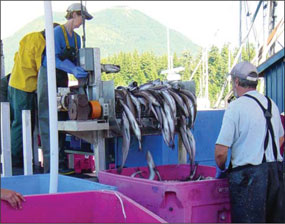 identifying and advancing provincial objectives as they relate to ocean resources and their use;
identifying and advancing provincial objectives as they relate to ocean resources and their use;- influencing implementation of the Federal Oceans Strategy on the Pacific coast;
- ensuring that federal management and international relations reflect provincial objectives for marine fisheries;
- representing B.C.'s interests to ensure the seafood sector's fair share of federal and cross government programs, initiatives
and activities to promote research, exports and investment;
- undertaking initiatives to enhance the competitiveness and sustainability of B.C.'s seafood products in domestic and export
markets.
Number of marine-based commercial and recreational fisheries managed through a collaborative decision-making process
Economic sustainability is dependent on the level and certainty of access to resources. The federal government has the constitutional
authority for the management and regulation of B.C.'s marine fisheries industry. To ensure an economic return on the resource,
the province must participate and be acknowledged as a key collaborative partner in the federal government activities related
to fisheries management. Measuring the increase in the number of B.C. marine fisheries that are managed collaboratively and
include provincial government participation, will determine if B.C.'s interests concerning fair allocation and certainty of
access to resources are represented.
The herring, hake and tuna fisheries are governed with a collaborative management regime that includes strong participation
from stakeholders and the Province of British Columbia. Together, hake, herring and tuna generate over $170 million11 in wholesale value to the B.C. economy. Pacific sardine is a developing fishery as sardine stocks returned to B.C. waters.
The province is working actively to promote similar collaborative management arrangements for the sardine fishery.
Sustainable fisheries require a global marketing regime that fosters and rewards the values of good stewardship. B.C. is committed
to developing sustainable fisheries in which fish populations are managed and harvested responsibly so the long-term environmental,
social and economic benefits of the fisheries are secured.
| Performance Measure |
2006/07
Baseline |
2007/08
Target |
2008/09
Target |
2009/10
Target |
| Number of marine-based commercial and recreational fisheries managed through a collaborative decision-making process |
3
(2005/06 data) |
4
(total) |
5
(total) |
6
(total) |
| Goal 5: |
A high performance organization. |
A high performance organization is reflected in its leadership, people, corporate operating systems, decision-making processes,
culture and the services it provides. It is flexible, able to adapt to situations and events, and is responsive to the needs
of its clients. A high performance organization provides a challenging and healthy working environment for staff, promotes
learning and is committed to continuous improvement.
Core Business Areas: Environmental Stewardship, Water Stewardship, Environmental Protection, Oceans and Marine Fisheries, Compliance and Executive
and Support Services.
Objective 1: A client-focused organization that supports high quality service.
A client-focused organization strives to identify and develop ways to continuously improve client service. The ministry anticipates
what its clients — the citizens, organizations and businesses of British Columbia — will need and how best to meet those needs
through responsive staff, effective programs, policy, legislation and decision-making, and timely information systems.
Key strategies for this objective include:
- continuing to foster collaborative and productive relationships with clients;
- identifying and implementing continuous improvements in client business processes.
Changes in the satisfaction of client groups
High performance organizations place a special emphasis on the delivery of appropriate, effective and responsive client-based
services. This performance measure has been chosen as an indicator of the level or extent to which client expectations are
being met by the ministry. In September 2006, a survey was conducted with representatives from business, industry, government,
First Nations, non-government organizations and academia. The intent of the survey was to establish the level of satisfaction
of clients who have regular contact with staff and an interest in the programs and services provided by the ministry. The client
satisfaction level identified by the survey results was used as a baseline from which to establish future targets for improvement.
Asking our clients how we are doing and what needs improvement is an ongoing process for the ministry. Building a better understanding
of our clients' needs and expectations provides the foundation upon which to improve our services and programs. An organization
that builds a reputation for quality service, objectivity and knowledge will also build citizens' confidence and trust in
the capacity and abilities of the organization.
Client satisfaction will be monitored over the coming years, and clients will be resurveyed every two years to measure changes
to baseline satisfaction rates.
| Performance Measure |
2006/07
Baseline |
2008/09
Target |
2010/11
Target |
2012/13
Target |
| Changes in satisfaction of client groups |
|
|
|
|
| (1) Client Satisfaction Index |
79% |
Maintain or improve |
Maintain or improve |
Maintain or improve |
| (2) Communication of shared stewardship |
55% |
Improve |
Improve |
Improve |
| (3) Consultation with stakeholders |
49% |
Improve |
Improve |
Improve |
Objective 2: A healthy working environment that supports and motivates staff, promotes innovation, and attracts and retains high performance
employees.
The ministry strives to ensure that it is a sought-after, well-respected and innovative place to work. Recognizing that a
challenging and balanced work environment is essential for good health and a productive workforce, the ministry recognizes
staff for their contributions, supports their work with appropriate resources, and encourages professional development opportunities
and health and wellness activities.
Key strategies for this objective include:
- updating and implementing the ministry's human resources strategy;
- optimizing performance by providing developmental opportunities, recognition and reward initiatives;
- advancing the development of a knowledgeable and skilled workforce;
- fostering a supportive workplace culture through leadership, health promotion and positive social relationships.
Objective 3: An integrated cross ministry framework that supports ministry goals and objectives.
Leadership and a coordinated approach to legislation and policy development, planning and reporting, resource allocation,
and compliance and enforcement services is essential to ensuring cross ministry consistency, effective and efficient program
delivery and the realization of ministry goals. The ministry works across core business areas to support goals and objectives,
improve outcomes, identify risks and focus on ministry and government priorities.
Key strategies for this objective include:
- providing a legislative and policy framework that supports ministry goals and objectives;
- providing support and streamlined outcomes through effective intergovernmental relations;
- facilitating a strategic and integrated approach to planning, measurement, evaluation and accountability;
- linking ministry resources with planning and results;
- tracking performance and reporting results toward the achievement of provincial environmental objectives;
- providing leadership and service in support of a strategic ministry compliance approach and maintaining strong and effective
compliance and enforcement services.
Objective 4: Information resources that support effective decision-making.
Science, socio-economic analysis and technology are fundamental tools for effective ministry decision-making. Application
of the best available science and sound economic analysis are key components of setting and evaluating the effectiveness of
environmental standards. Well-managed, accurate and accessible information is critical to making informed environmental and
business management decisions.
Key strategies for this objective include:
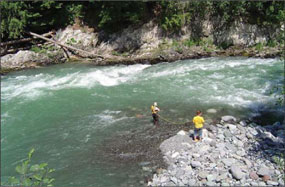 maintaining access to the best available science through in-house expertise and partnerships with research agencies and universities;
maintaining access to the best available science through in-house expertise and partnerships with research agencies and universities;- monitoring the effectiveness (i.e., the impact) of standards of environmental values such as water and air quality, and health
of ecosystems;
- providing tools to better integrate scientific information with the social and economic factors considered in resource management
decisions;
- developing effective information resources to facilitate effective environmental decision-making;
- pursuing opportunities to maximize the use of technology and best practices in the management of information resources.